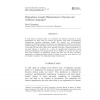Free Online Productivity Tools
i2Speak
i2Symbol
i2OCR
iTex2Img
iWeb2Print
iWeb2Shot
i2Type
iPdf2Split
iPdf2Merge
i2Bopomofo
i2Arabic
i2Style
i2Image
i2PDF
iLatex2Rtf
Sci2ools
JQL
2008
2008
Dependency-length minimization in natural and artificial languages
A wide range of evidence points to a preference for syntactic structures in which dependencies are short. Here we examine the question: what kinds of dependency configurations minimize dependency length? We consider two well-established principles of dependency-length minimization; that dependencies should be consistently right-branching or left-branching, and that shorter dependent phrases should be closer to the head. We also add a third, novel, principle; that some ``opposite-branching'' of one-word phrases is desirable. In a series of computational experiments, using unordered dependency trees gathered from written English, we examine the effect of these three principles on dependency length, and show that all three contribute significantly to dependency-length reduction. Finally, we present what appears to be the optimal ``grammar'' for dependency-length minimization.
| Added | 13 Dec 2010 |
| Updated | 13 Dec 2010 |
| Type | Journal |
| Year | 2008 |
| Where | JQL |
| Authors | David Temperley |
Comments (0)

